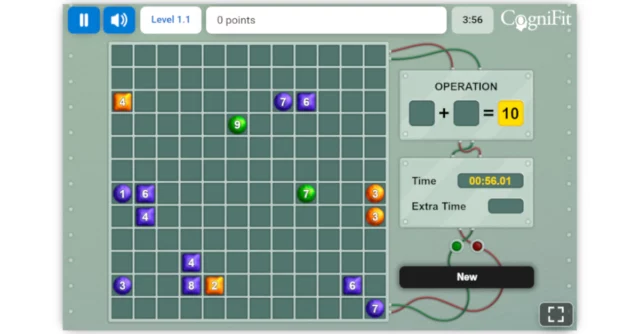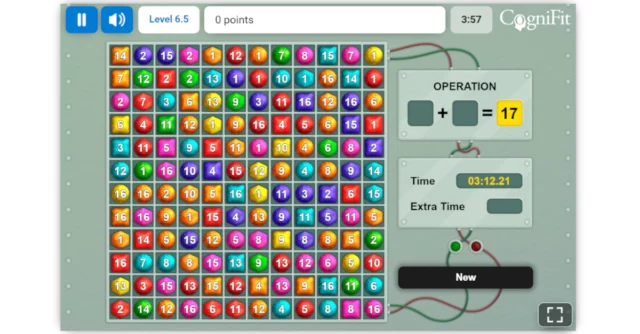
Math Twins – Addition But With Twists & Turns
If you’re a numbers fan, or you’re looking to add a different kind of brain game to your weekly collection, Math Twins might be the one for you! In today’s feature, we will be looking at how the game works and what part of the brain it targets.
Let’s dive in!
How to Play Math Twins
5+5, 6+4, 3+7, 8+2, 9+1 = 10
This is all you really need to know in terms of math when it comes to this CogniFit game. So, no need to have a mathematical panic attack or break out any calculators.
When you start up the game, you’ll go through a standard tutorial. However, the basic premise is simple. In the upper corner, you’ll have a total sum. For example, 12. Your job is to click on two numbers that will add up to 12.
But, as always, there are twists that will make your brain flex its cognitive muscles. A timer will force you to concentrate, and any two numbers must have a “clear path” between them with no more than two direction changes.
It might take a bit of practice to get the hang of things, but it’s quick a clever game. Also, if you want a challenge, harder levels can get really difficult, since there is less free space to work with and way less time on the countdown clock.
Next, let’s take a closer look at the cognitive abilities you’ll be using in Math Twins.

Focused Attention
There are no special explanations needed here, because it’s exactly how it sounds. Everyone’s had problems focusing on something. Maybe they’re stressed or tired. Maybe it’s too complicated.
But did you know there’s a lot more working against you than you realize? There’s…
- Personal Factors: Level of activation, motivation, emotion, or sensory modality that processes the stimulus. We’re more likely to process a stimulus correctly when we’re awake and motivated, rather than sad or tired, or bored
- Environmental Factors: It’s easier to pay attention to a stimulus or target activity if there are few environmental distractions, and it becomes more difficult to concentrate with more frequent or intense distractions.
- Stimulus Factors: Novelty, complexity, duration, or salience of the stimulus. If there is only one single, simple, obvious stimulus, it will be easier to detect it.
Due to the time limitations of Math Twins, you are forced to hone your Focused Attention to find the pairs before the timer runs out!
Spatial Perception
This cognitive ability might sound simple, but it’s a bit trickier than some of the others. Mostly because it relies on two “processes” to work properly.
- Exteroceptive, which creates representations of our space through feelings,
- Interoceptive, which creates representations of our body, like its position or orientation.
It lets us understand our relationship between objects. Without it, we wouldn’t be able to think in 2D or 3D concepts. Our eyes and bodies work together to stop us from bumping into things and help us get dressed. Spatial perception may be affected in some developmental disorders like autism, Asperger’s, cerebral palsy, as well as others
Math Twins uses the “clear paths” or “limited turns” as a way to trigger this cognitive skill.

Visual Scanning
You’re in a rush to go to work and you can’t find your phone. So, you scan the room until you see it sitting on the bedside table. Or perhaps you’re driving and need to see if there’s a safe space to change lanes?
There’s not a time that goes by that we don’t use the cognitive function Visual Scanning. It’s what’s lets us quickly look around our environment for whatever relevant information we need. It’s also the 4th function in a series of visual abilities that our brains need to interact with what’s around us.
- Selective/Focused Attention – we need to be able to focus on what we want to look for.
- Visual Perception – is the ability to distinguish shapes, colors, sizes, and other identifying markers that make up an object
- Recognition – Our brains need to know we’ve seen the information before. Meaning, we can’t find “our” car keys if we’ve never seen them before.
- Finally, Visually Scanning – After all the other abilities have done their job, we can look around and find our goal.
Some jobs like police officers and detectives need visual scanning as a key element of their jobs. But so do things like academics or everyday actions like driving. Math Twins makes you scan the board for matching numbers that will add up to the wanted sum.
Math Twins Conclusion
If you’re a numbers fan, this game is one you’ll want to add to your weekly collection. But, if you’ve never tried brain training before, you can jump over to CogniFit and see what other brain games are available. All you need is to play for 20 minutes per session and 3 sessions per week!












